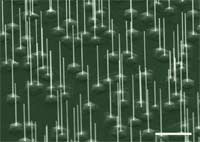Transistors are an indispensable building block in electric appliances, where they amplify weak electric currents. Now researchers have developed a new type of transistor that is 50 times more energy efficient than today’s models. It is also the first to be developed using nanotechnology.
“This kind of transistor should be able to reduce energy consumption in mobile phones and computers, for example, so they wouldn’t have to be recharged so often. What’s more, it can pave the way for communicating in frequencies that are too high for today’s technology,” says Lars-Erik Wernersson, professor of solid state physics at the Faculty of Engineering, Lund University, in Sweden.
For some time researchers have been stymied by the fact that transistors can’t be reduced any further in size without overheating, since the electrons release so much energy.
“But our model is made up of indium arsenide, where the electrons move more easily compared with silicon, the conventional semiconductor material in transistors. Actually, it’s hard to produce transistors with indium arsenide, but if we apply nanotechnology, it’s rather simple,” explains Lars-Erik Wernersson.
The transistor is thus constructed using nanotechnology. According to Lars-Erik Wernersson, this means that the material is self-organized according to a bottom-up principle instead of being “carved out,” which is the conventional method.
Ultimately Lars-Erik Wernersson and his colleagues also hope to develop transistors that can communicate in entirely new frequency areas. Today’s electric appliances use 3–10 gigahertz. The hope is to reach 60 GHz, which is a considerably broader frequency range.
“With 60 GHz you can only communicate across short differences and not through walls, for instance. But this new frequency range can rationalize wireless communication in the home, for example when you download a film or communicate between TVs and projectors. We know for sure that such electric appliances will be integrated more and more in the future,” he adds.
There are other scientists in the world working with similar research-at IBM in the U.S., for example-but these Swedish researchers have made the most progress in this field.
Recently Lars-Erik Wernersson was informed he would receive SEK 24.5 million from the Swedish Foundation for Strategic Research to develop new wireless circuits using nanotechnology. The newly developed transistor technology will serve as the basis for the new circuits. The transistor has been partly developed in collaboration with the spin-off company QuNano.

